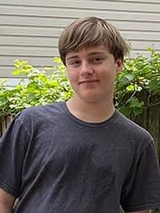Interstitial Lung Disease: Quinn’s Story
Interstitial Lung Disease: Quinn’s Story
Fifteen-year-old Quinn was born extremely premature after only 25 weeks in his mother’s womb, and had a rough first couple years of life, according to his parents, Jennifer and Chad.

Watching their “miracle baby” overcome myriad health issues — including two holes in his heart, underdeveloped lungs, kidney reflux and a head tilt — and grow into a sports-loving, straight-A student, they thought the worst was behind them.
Understandably, hearing the words, “You have a very sick child,” wasn’t the news the couple from Chicago, Illinois, was hoping for about their son. But that consultation at Vanderbilt University Medical Center in Tennessee with Lisa Young, MD, now Division Chief of the Division of Pulmonary and Sleep Medicine and Co-director of the Rare Lung Disease Center, at Children’s Hospital of Philadelphia (CHOP), proved to be exactly what he needed.
It was two months before Quinn’s 10th birthday and a year after his local pulmonologist at the Ann & Robert Lurie Children’s Hospital in Chicago diagnosed him with interstitial lung disease, an umbrella term for a large group of diseases that often cause inflammation and scarring of the lungs.
Knowing that Dr. Young, widely considered the world’s best in treating kids’ rare lung diseases, was on Quinn’s side five years ago, and still is now as his ongoing consulting physician, makes all the difference in their world.
Because Quinn’s ILD is of uncertain origin, his is a case that researchers at CHOP, in partnership with other pulmonologists around the country, continue to better understand and develop new treatments for kids like Quinn through collaboration with experts in radiology, pathology and genetics.
Going the distance for CHOP’s expertise
It was in March 2016 that Quinn developed a runny nose, fatigue and chills, all the symptoms of a cold but serious enough that his father kept the third-grader home from school. With Jennifer away for work, Chad took Quinn to his pediatrician, who diagnosed him with pneumonia, requiring immediate oxygen and an emergency ambulance ride to Lurie Children’s.
“We’d finally gotten to a point when he got a cold, and we didn’t freak out, so much so I went on a business trip,” says Jennifer.

Chad recalls how quickly his son’s breathing became labored, his oxygen level dropped to 78, and his lips turned blue.
“I just didn’t understand. I kept asking myself how is this possible?” says Jennifer, who flew home and went directly to the hospital, where Quinn and his parents stayed for a month.
Quinn underwent a series of tests, including a bronchoscopy, and a CT scan that revealed his lungs had widespread abnormalities described as ground glass. He had early signs of pulmonary hypertension and his digits looked slightly clubbed, all of which combined to lead to the ILD diagnosis. On top of everything else, Quinn was diagnosed with swine flu, which required two weeks of isolation at the time.
It was not until he was administered a dose of IV steroids that his oxygen level improved enough that he could be released. Quinn went home with a prescription for oral steroids, which over time affected both his appearance and his personality, and orders to use oxygen when needed, which was mostly when he slept.
A collaborative plan
Frustrated by Quinn’s lack of improvement, his parents acted on their local pulmonologist’s recommendation to see Dr. Young. After a full day of testing, Quinn and his parents left with a new treatment plan, including round-the-clock oxygen and a monthly infusion of steroids. Dr. Young also wanted Quinn to follow-up at Lurie Children’s with pulmonary function and genetic tests, while she maintained contact with his local doctors, via email and conference calls. When Dr. Young joined CHOP in 2019, Quinn’s care came with her to Philadelphia.
When Quinn most recently traveled to CHOP to see Dr. Young, she was pleased with Quinn’s improvements and proceeded to talk for several hours, about his case and developments in research, Jennifer recalls.
Ongoing research for answers, better treatments
Though they still do not know the exact type of Quinn’s interstitial lung disease, Quinn no longer requires supplemental oxygen, and he hopes to soon start a new drug that will eliminate the need for the IV steroids.
Quinn’s parents cannot say enough about Dr. Young and her teams. “If anyone can figure it out, it is Dr. Young,” Jennifer says of Quinn’s disease, noting her son participates in research studies to hopefully help himself and others.
Quinn says when his disease is finally discovered, he wants it to be named after him, according to his parents.

Quinn, who has stopped playing sports, continues to find ways to have fun with his friends, and he has kept up his stellar grades. While the experience has been both frightening and maddening for Quinn at times, his relatives, teachers, friends and neighbors have rallied to support him.
“To look at Quinn now, you wouldn’t even know he had a problem,” says Jennifer, noting that sometimes she must remind teachers about his absences due to medical appointments.
Quinn just finished his first year of high school. But the teen who built a computer from scratch with parts he bought on Amazon, is already thinking about college, and a possible future in the field of computers.
“He talks about wanting to design better medical equipment,” his mother says.
And when the time comes, Quinn’s parents already know if he chooses to live away from home, Dr. Young will help devise a college plan that meets his medical needs — whatever they are at the time, and wherever he is.
Meanwhile, his parents say there is no deterrent to Quinn receiving the best care available — including travel. Between that drive years ago to Vanderbilt and a more recent flight to CHOP, both trips specifically to see Dr. Young, they have racked up over 1,200 miles — so far.
“Whatever it takes,” Jennifer says.